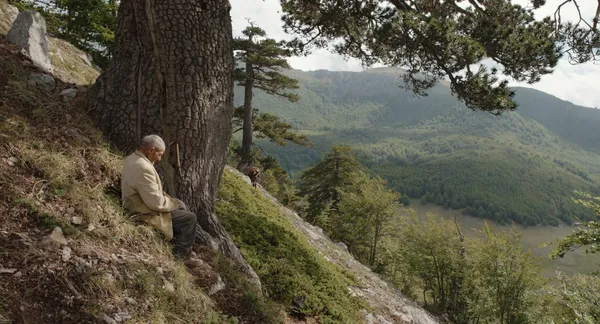 |
| Michelangelo Frammartino on Nicola Lanza, the shepherd in Il Buco (The Hole): “His face seems like the bark of a tree; it seems created by the stones of the Pollino.” |
When I spoke with Michelangelo Frammartino in 2013 at the Tribeca Film Festival MoMA PS1 world première of Alberi, hosted by Artistic Director Frédéric Boyer, I mentioned that he should check out James Turrell’s Meeting on the third floor. Now in 2022 he sees the connection to Meeting and the opening shot by cinematographer Renato Berta (an Alain Resnais, Louis Malle regular) in Il Buco (The Hole), co-written with Giovanna Giuliani and produced by Marco Serrecchia.
 |
| Michelangelo Frammartino with Anne-Katrin Titze and the rock on shepherds: “They have this ability to never appear, and therefore they are the voice of the mountain.” |
Bird sounds start the film, as we see the sky from below, from the perspective of a cave with a vaguely horseshoe-shaped opening. The Calabrian landscape of Il Buco (a highlight of the 59th New York Film Festival) is filled with the sound of animal bells, curious cows flapping their ears, individual trees with more character than many an actor, and mist rising over the valley. A shepherd talks “oh-oh-eh-eh” to his flock, to the mountain, as his donkey waits on the path. Same spot; they know, we know.
During the same month in 1961 when the completed Pirelli Tower in Milan stretched to the heavens, an expedition of speleologists went deep underground in Calabria to explore the Bifurto Abyss, the second deepest cave in the world. At daybreak, the scientists awake in the church storeroom, next to Jesus on the cross, who rests on the floor just as they did. They drive to “the hole” which gives the film its title. At the entrance to the underworld, they toss a stone down and set on fire pages from a magazine featuring pictures of Sophia Loren, John F Kennedy, Richard Nixon.
Up above, we revisit the spot where the shepherd and the donkey had congregated (the magical) three times before. Now he is gone. At the campground, the explorers are greeted by a horse looking into one of the tents. Someone is playing with a ball across the abyss. Our perspective is from below. More and more we are put into a claustrophobic point-of-view.
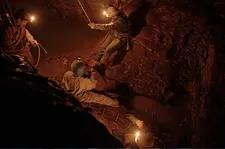 |
| Speleologists explore the Bifurto Abyss in Il Buco |
From Milan, Michelangelo Frammartino joined me on Zoom for an in-depth conversation on Il Buco.
Anne-Katrin Titze: Michelangelo, so good to see you again! After all those years!
Michelangelo Frammartino: Ciao! Yes, a long time!
AKT: Since Alberi at PS1! Frédéric Boyer introduced us and I remember telling you about the James Turrell installation [Meeting on the third floor] there.
MF: Yes, I remember perfectly. And I went on the roof to see it. Yes, yes, I remember perfectly, it’s here in my mind.
AKT: Actually I was thinking of it with the first shot of Il Buco.
MF: Yeah, yeah!
AKT: Because you have a shot from the hole to the sky! And this is what James Turrell does at PS1, he has a hole in the roof!
MF: You are always right, you are always right, yeah. Yes, I understand now that maybe there’s a connection, thank you! Yes, it’s connected. You’re right.
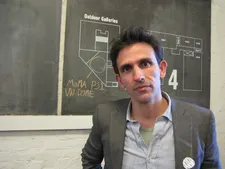 |
| Michelangelo Frammartino at MoMA PS1 for the world première of Alberi Photo: Anne-Katrin Titze |
AKT: First of all, I absolutely loved Il Buco. It touches on a dream of humanity - that we always want to go to heaven and go to hell. We want to discover what is up there and what is down below. Was that one of your starting points?
MF: I’m loving the way this interview is starting out. I really love this perspective. I live in Milan in the North of Italy but I need to go to the South often. I need those two perspectives, I need the top and the bottom, the high and the low all the time.
And by this I do not mean at all that Milan is heaven and Calabria is hell. Obviously, because you find hell in Milan and heaven in Calabria. But we do need those two dimensions. You know, the North and South, high and low, top and bottom, which are vital also symbolically. I do agree with that.
AKT: That reminds me of a poem by Bertolt Brecht about Hollywood, that you don’t need heaven and hell. For the unsuccessful this heaven will be hell automatically. But I want to get to your fantastic cinematographer Renato Berta, known from Alain Resnais films, Louis Malle, etc. How did he for this particular project become your cinematographer?
MF: My partner and producer Marco Serrecchia had worked with him at a project and Giovanna Giuliani, who co-wrote the movie with me, had acted in a movie by [Jean-Marie] Straub, which had been photographed by Renato Berta. Therefore there are some significant people that are involved in this project, that had been part of the film’s journey, who knew him well and that’s what let us to working with Renato. That is the starting point for the collaboration.
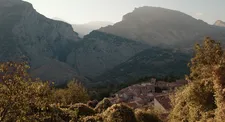 |
| Calabrian landscape in Il Buco |
I confess I was really concerned about making a period piece. I have never been in a situation where I had to shoot a movie which was so specifically characterised by a historical period, in this case the early Sixties. Therefore we asked Renato, who, as you said, is a man with an incredible experience in the film industry and also, I would like to add, is a great eye of the 20th century, to supervise the photography to some extent and help us find the right cinematographer. We didn’t think that Renato would even consider to take it on himself.
AKT: It’s great.
MF: And the funny thing was that when Renato understood that I wanted to film pitch black, the absolute darkness and in the movie there will be absolute black - because when you’re in the cave, I did not want to use any additional light - I wanted for the cave to be lit simply by those hat lamps that people wear.
When he understood that it would be pitch black and absolute dark, he started smiling and he said “You know, for me in a film, that kind of black was always a mistake. There’s always supposed to be some underexposure, but never absolute black. And yet, you’re thinking of doing that! You know what? I would like to make this myself.”
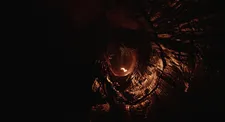 |
| Magazine page set on fire by a speleologist in Il Buco to light the cave |
AKT: It’s so interesting. You mention that it’s a period piece, 1961. There are two types of nostalgia that it also appeals to, because you are not having a juxtaposition between nature and a more modern, recent skyscraper, no, it’s the Pirelli Tower skyscraper from 1961, together with a much more ancient history.
Your choice of magazine pages that are set on fire [to calculate the depth of the cave] are interesting too. You chose Sophia Loren and Kennedy and Nixon. In a way the memory of the world above is set on fire and sent to the world below?
MF: Actually, that particular time in history is very important for me in my own life because that’s the year in which my father decided to leave Calabria - actually both my father and mother are from Calabria, they were born in the South. As you probably know, Anne-Katrin, our country is divided in two, the North has a certain way of being and is set up in a certain way and the South is completely different. Our country was unified in 1861, that is exactly 100 years before that date, with an operation that was quite complicated to create national unity. In terms of social equality for example, that national unity was never accomplished.
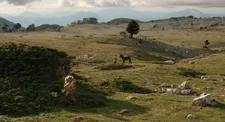 |
| Shepherd with his donkey and cows in the Calabrian landscape |
In 1961 my father understood that the time had come to go to the North, to leave his own land. And just like my father, millions of Southerners go to the North to try their luck to build a future for themselves. Those are years in which there is this traveling up, this push towards the top. You go toward the North from the South, looking for a better life. And there is this vertical push, this draw to the above, to what is higher. And symbolically this is easy to perceive, it’s palpable. The Pirelli skyscraper is not a coincidence. It was nicknamed “the ceiling of Europe.”
It symbolically was to represent Italy back on its feet again. At the same time, Mr. [Walter] Bonatti, who is a great Alpinist, in 1961 attempts to climb Mont Blanc from the Central Pilone - that’s another example, not so much of the demonstration of strength of Italy. Actually just a few years ago he had climbed the K 2 to show to the world that the challenges were over, that it was a new era.
We had Gagarin going to explore Space, up in the skies in the atmosphere. In that year the world was strongly looking towards the top, towards what’s high up and in that historical moment I was very fascinated by the fact that this group of kids attempted a mission which was the very opposite. They go towards the South, the bottom, towards that place where I have my roots.
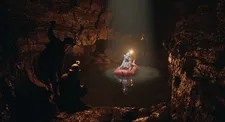 |
| Michelangelo Frammartino on François Ellenberger’s Le mystère de la mémoire: “There’s a book that had a profound influence on the building of this story, which does have something mythical …” |
AKT: Roots is very appropriate in this context.
MF: You also mentioned Sophia Loren and Nixon and Kennedy. Of course there are years of visibility, of notoriety with television allowing all kinds of people to become famous one day to the next. On TV you had those gameshows and even people who were nobody until the day before can be famous overnight. So in this sense, what happened here is the very opposite. These kids choose darkness. They choose to go to a place where there’s no light.
And I want to add just one last comment - they carry out an extraordinary mission, because the exploration of the Abisso del Bifurto, which is the second or third deepest cave in the world - well at the time it was imagined as an upside-down K2. They do all that, which is an extraordinary accomplishment, and they don’t tell anybody!
AKT: I want to also talk about the shepherd and the wonderful face of the shepherd. Also for structuring, you repeat the same shot, the same angle, three times before he disappears. We see him, we hear the “oh-oh-eh-eh” sounds he is making, the donkey is in its spot - it is as in a fairy tale repeated three times.
 |
| Michelangelo Frammartino with Anne-Katrin Titze on Milan and Calabria: “I need those two perspectives, I need the top and the bottom, the high and the low all the time.” |
You take the structuring device of old mythology connecting to nature and at the same time, down below, in the caves the walls look like meat. I have a rock here that I took because it looked like meat. You have a connection of things that don’t usually connect, no?
MF: This is a beautiful question and a very complex one. I’ll try to answer as best as I can. Shepherds belong to the mountain. When you go to the mountains you hear their voice but you never see them. Because they have this ability to never appear, and therefore they are the voice of the mountain.
And Nicola [Lanza], this particular shepherd, as you mentioned, has a wonderful face, I agree with you. His face seems like the bark of a tree; it seems created by the stones of the Pollino. It is a piece of the mountain itself, Nicola is that. It is true that there is a deep connection between this exploration of the mountain and the shepherd. And the shepherd is the mountain itself. It is no coincidence that Sinicola becomes sick at the very moment in which the cave explorers enter into the mountain.
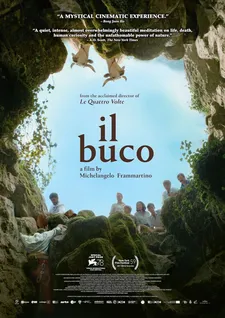 |
| Il Buco poster |
AKT: That’s how it felt.
MF: And then he ends up dying in the very moment in which the cave explorers reach the bottom of the mountain. There’s a book that had a profound influence on the building of this story, which does have something mythical, I agree with what you said earlier. It is the book by a French geologist, François Ellenberger, who was a scientist, a well-known geologist, who was the president of the French Society of Geology. When he was young, from 1940 to 1945, he was detained in a concentration camp in Austria, if I’m not mistaken.
When he was in this concentration camp, an experience he obviously survived, he was not able to work as a geologist. He could not explore caves and volcanos and canyons or any of that. So what he did was exploring himself, with the geological approach. So he explored his memories and his dreams and his moments of happiness. He did an immersion, a deep dive within himself, considering himself as a mountain. This is the book that he wrote after that when he saved himself from the concentration camp. The title of the book is Le Mystère De La Mémoire, The Mystery Of Memory.
AKT: The wisdom of the earth in all of us! Thank you so much!
MF: Grazie!
Il Buco is in cinemas in the US.





















